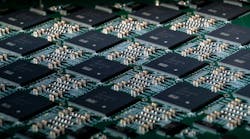To help sustain U.S. leadership in semiconductors over the long term, chipmakers said the U.S. should allocate funds from the CHIPS and Science Act to build new research and development labs. In addition to tens of billions of dollars for rebuilding U.S. chip manufacturing capacity, it also brings billions of dollars to reinvigorate the nation’s existing R&D facilities.
The Semiconductor Industry Association (SIA), a trade group that represents top U.S. chip firms, urged the U.S. to carefully consider these facilities, including national labs, universities, and research labs run by U.S. companies, as candidates for expansion.
The recently passed legislation will reserve $2 billion for the Defense Department and $11 billion for the Commerce Department—about 25% of the total $52 billion price tag of the bill—to invest in R&D programs.
However, that funding is only a fraction of the $50 billion or so that the U.S. chip sector invested in R&D last year alone. Thus, semiconductor companies are looking for ways to push the funding as far as possible. They also want to make sure the U.S. is careful not to spread out funding over so many different efforts that it becomes ineffective. Spending too aggressively in a single location or on a single technology would be another misstep, said the SIA.
The trade group said the Defense Department funding would primarily go to existing programs, likely many of the electronics-related programs run by the Defense Agency Research Projects Agency (DARPA). The remaining funds will be allocated through two new government entities: the National Semiconductor Technology Center (NSTC) and the National Advanced Packaging Manufacturing Program (NAPMP).
The SIA, in a report released last month with the Boston Consulting Group that proposes how to spend the funding, pointed out that many U.S. chip companies currently work with the likes of the Interuniversity Microelectronics Center (imec) and the Semiconductor Research Corporation (SRC) on pre-competitive R&D. But the SIA warned that the U.S. should not use funds from the CHIPS and Science Act to try to replicate these these organizations.
Instead, the funds should go toward building and enhancing facilities that help bridge the gap between early-stage research and more mature mass-production technologies. The report states both are currently well-funded in the U.S.
Bridging the Gap
More importantly, the U.S. should use the funding to build and strengthen R&D expertise in new technologies, such as advanced materials and heterogenous integration, where no one—not even the U.S.—has taken the lead yet.
To do so, the trade group said that it will be critical for the U.S. to enhance the capabilities of existing infrastructure, such as the Albany NanoTech Complex in New York, instead of investing in new construction.
The focus should be on identifying technologies that are roughly 5 to 15 years from production. Then funds should be allocated in a way that helps companies through the process of prototyping and subsequently scaling them up for commercial use.
The SIA called on the NSTC and NAPMP to partner widely with players in the U.S. semiconductor industry and operate as hubs where companies and government agencies can come together to align R&D efforts. That way, as the trade group tells it, companies will be able to participate in programs where they have interests, while U.S. agencies will still have the freedom to pursue their own priorities.
The report said the U.S. also should focus on full-stack innovation, coordinating with U.S. companies to solve challenges spanning advanced materials, architectures, packaging, software, and more: “Full-stack innovation is hard. Modern semiconductor companies are often highly specialized in distinct layers of the stack, and the U.S. ecosystem currently lacks the mechanisms to coordinate this collaboration.”
Specifically, the NAPMP also could convene experts to contribute to standards groups, including the IEEE and JEDEC, putting the U.S. on the front lines when it comes to shaping standards in heterogeneous integration and chiplets.
Furthermore, the report urged the agencies to promote a range of programs that expand the supply and skills of the U.S. chip R&D pipeline and workforce to bolster the R&D ecosystem and economic competitiveness it underpins.
An inadequate supply of highly skilled workers in R&D roles—in areas ranging from semiconductor design to manufacturing to other activities in the sector—threatens to limit the pace of innovation, the report claimed.

